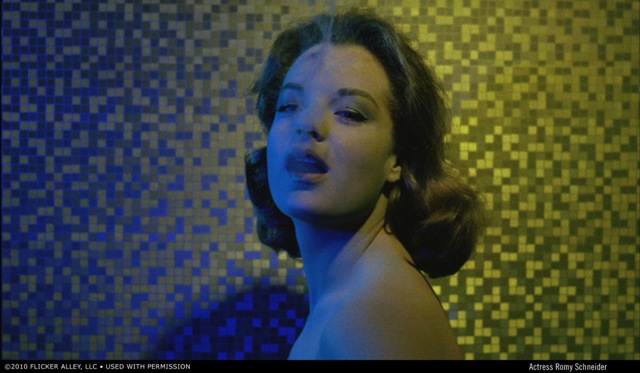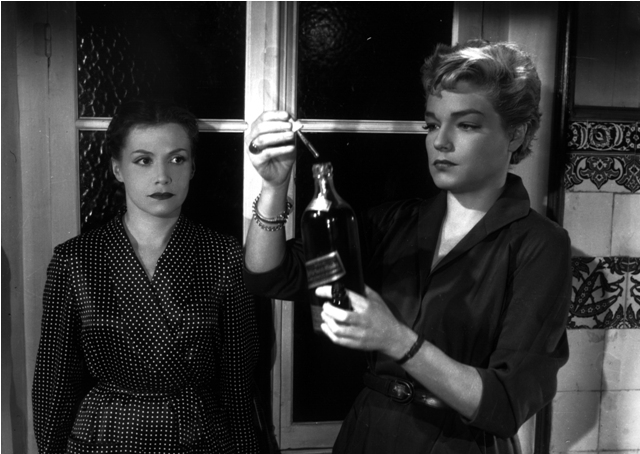CHICAGO – The Steppenwolf Theatre of Chicago continues to provide different viewpoints on the American stage, and their latest “Little Bear Ridge Road” is no exception. Featuring ensemble member Laurie Metcalf, it’s the resonate story of a family at the crossroads. For tickets/details, click LITTLE BEAR.
Film Feature: ‘Monsieur Noir: Henri-Georges Clouzot’ Thrills at Siskel Film Center
CHICAGO – What truly defines a master of suspense? Is it the skill of keeping an audience’s attention rapt with slick pacing, elaborately designed set-pieces, and a whopper of a twist ending? Or is it simply the ability to viscerally convey the psychological trap of a character until the audience feels confined within it, and every onscreen gasp, scream and shiver becomes the viewer’s own?
Henri-Georges Clouzot is one of the few filmmakers in cinema history who not only warrants comparison to the legendary Master of Suspense himself, Alfred Hitchcock, but deserves to be considered his equal (both men were greatly fond of storyboards). Though he only made a quarter as many pictures during his career, which spanned nearly four decades, he made some of the most influential and spellbinding thrillers ever made, including two renowned masterpieces, 1953’s “The Wages of Fear” and 1955’s “Diabolique.” The latter film certainly justifies Clouzot’s reputation as “the French Hitchcock.” Interestingly enough, the same authors that penned the source material for “Diabolique” went on to write another novel that was adapted into Hitchcock’s most personal film, “Vertigo.”
With its swirling vortexes, groundbreaking visuals, heightened melodrama, and themes of obsessive passions skirting the edge of sanity, “Vertigo” seems to have been one of Clouzot’s inspirations when he set out to make “Inferno,” his audacious 1964 project that never saw completion, or the light of day. Filmmakers Serge Bromberg and Ruxandra Medrea feature never-before-seen footage of the doomed project in a new documentary that is scheduled to have its first Chicago run at the Siskel Film Center, a fitting end to the venue’s splendid September retrospective, “Monsieur Noir: Henri-Georges Clouzot.” The festival, which kicked off Sept. 11 and runs through Sept. 30, is supported by CulturesFrance and Cultural Services at the Consulate General of France in Chicago. It features five classic Clouzot films in addition to the Sept. 24 premiere of Bromberg and Medrea’s documentary, “Henri-Georges Clouzot’s Inferno.”

Inferno
Photo credit: Siskel Film Center
First up is 1943’s fearless landmark noir “Le Corbeau,” which created a storm of controversy upon its initial release, with its anti-Nazi and anti-Vichy sentiments. It centers on a country town in occupied France where an anonymous troublemaker reveals dastardly secrets about the community’s inhabitants. This rare classic was banned after the war, and resulted in Clouzot being blacklisted for four years. His next film, 1947’s searing noir “Quai Des Orfèvres,” will screen at the festival in its pristine 2003 restoration from Rialto Pictures. It’s a brilliant, under-appreciated whodunit in which a police inspector (memorably played by Louis Jouvet) attempts to solve a brutal murder.
Clouzot’s friendship with Picasso and their shared fascination over the process of artistic creation led them to collaborate in a stunning 1956 documentary, “The Mystery of Picasso,” that is an absolute must-see for art lovers and film buffs alike. It chronicles various artworks by Picasso, which were created especially for the film (and destroyed after production wrapped), from conception to completion, allowing the immortal painter’s genius to unfold before the viewer’s very eyes. Equally worth catching is “La Vérité,” Clouzot’s explosive 1960 drama featuring Brigitte Bardot in a performance many film historians consider to be her best. She plays true-blooded nonconformist whose sexually loose lifestyle may have played a key role in leading her to be accused of murder.
Yet perhaps best of all is 1955’s “Diabolique,” which is quite simply one of the greatest suspense films ever made. It stars Clouzot’s own wife, Vera, as a frightened woman who kills her loathsome husband (Paul Meurisse) with the help of his bitter mistress (Simone Signoret). The film has elements of a classic ghost story, as the newly widowed wife starts to suspect that her fearsome spouse is still among the living, particularly after his body disappears. Clouzot rackets up the tension to a gloriously excruciating degree, resulting in a climax that is among the most shocking and unforgettable in film history. It’s the type of film that begs to be seen in the darkness of a theater, and the Siskel Center has reserved an archival print of the picture that is nine minutes longer than the U.S. version.

Diabolique
Photo credit: Siskel Film Center
Both “Diabolique” and “Vertigo” are haunted by the spirits of characters who may or may not be dead. Yet while Clouzot’s earlier work was entrenched in the structured style of noir, “Inferno” was an entirely different animal, evoking a feature length version of the phantasmagorical nightmares that plague Jimmy Stewart’s obsessed detective in “Vertigo.” Though Bromberg and Medrea’s collection of interviews and footage may be too frustrating and open-ended to satisfy casual viewers, it is essential viewing for film scholars eager to take a closer look at the psyche of Clouzot through the fragments of his unfinished art. Like Hitchcock, Clouzot took an almost fetishistic glee in framing his sensuous leading lady, Romy Schneider, who’s the subject of various dazzling, abstract shots witnessed throughout the documentary. The imagery bears some striking resemblances to “Vertigo,” particularly when Schneider’s eye twists into a spiral.
Such distorted, psychedelic scenes are meant to take place in the mind of Marcel (Serge Reggiani), a man who suspects his wife (Schneider) is having an affair with a mechanic (Jean-Claude Bercq). The documentary stages selected scenes from the film, allowing contemporary actors to recreate various dialogue passages from Clouzot’s script. Bromberg and Medrea also compile some enlightening insights from Clouzot’s collaborators, who each share a distinctive perspective on the troubled production. Assistant director Bernard Stora says the film was a drama of jealousy, and “not particularly thrilling” in terms of plotting. Yet it is clear from the footage that Clouzot had intended for the film to revolutionize cinema. Since the studio provided him with an unlimited budget, and a crew secure in their trust of the difficult yet consistently triumphant filmmaker, Clouzot took the opportunity to experiment with the form, in hopes of transcending it. If completed, the film may have been an indulgent exercise on the order of David Lynch’s “Inland Empire,” allowing the artist full rein to explore his vision without limitations. Yet Clouzot’s confidence began to falter, which ended up proving fatal for the project, and nearly proved fatal for the 67-year-old director, whose sudden heart attack swiftly brought production to a close.

Quai Des Orfevres
Photo credit: Siskel Film Center
Camera operator William Lubtchansky amusingly recalls how he “had to be the specialist of optical coitus,” zooming his lens in and out at an increasing speed. On the set, Clouzot thought his collaborators were “holding back,” while the majority of the crew thought their leader had become hopelessly lost. Schneider courageously remained dedicated to the filmmaker, whose torturous demands on his actors were well-known in the industry. His fiery perfectionism ultimately proved too much for Reggiani, who would spend several days running in front of a camera for miles and miles without ever being clued in on his destination.
Yet there’s plenty to savor in “Inferno,” and enough to make viewers contemplate what significance the finished product may have had. What the documentary doesn’t mention is the fact that Clouzot’s script was adapted by Claude Chabrol into 1994’s “Hell,” featuring Emmanuel Béart. Though Chabrol has also been considered a filmmaker of Hitchcockian proportions, his version of the “Inferno” script had none of the ambition of a filmmaker liberated by the chance to make his own “8 1/2.” It’s exhilarating to watch Clouzot tinker with endless forms of cinematic trickery, many of which seem inspired by other filmmakers. In one scene, the characters’ faces fuse together in a style reminiscent of Ingmar Bergman’s “Persona.” In another, a series of eyes are juxtaposed together in a scattered pattern worthy of Fritz Lang’s “Metropolis.” Schneider is both bizarrely erotic and oddly haunting, especially when a clockwork stream of emotions register on her face, which is caressed by a colorful, revolving light. If “Inferno” proves any cinematic principle, it’s that the indulgence of a genius will always be far more interesting than the restraint of a hack.
For showtimes and ticket information, visit Siskel Film Center.
 | By MATT FAGERHOLM |


